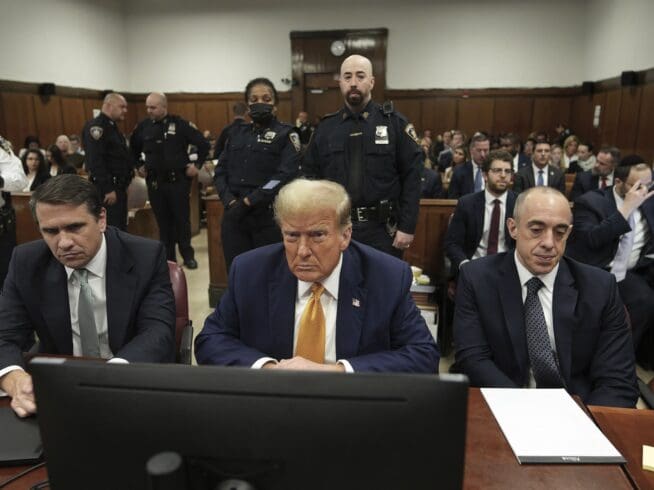Your guide to absentee voting in Wisconsin
Here’s everything you need to know about requesting, filling out, and returning an absentee ballot.

Amid unprecedented attacks on elections and election workers across the country, Republicans are reviewing and rewriting election rules. In Wisconsin, Republicans have changed the rules for absentee voting.
This is your guide to prepare for the year’s upcoming elections. It answers questions about the changes that have been made, the changes that have been proposed and are still pending, and what has remained the same.
Request your ballot
Anyone can vote absentee in Wisconsin. There aren’t specific requirements a voter needs to meet, as long as they are registered to vote. Voting by mail became popular at the height of the COVID-19 pandemic as a way to avoid the risk of infection. Many vote absentee because they’re traveling on Election Day, and some people do it because it’s just what they prefer — any reason counts.
Voting by mail takes some advanced planning. First a voter has to request a ballot either online or through the mail. The deadline for most voters to request an absentee ballot is the Thursday before an election, but the Wisconsin Elections Commission urges voters to not wait until the last minute to request the ballot, since it takes time for local clerks to verify voter information and prepare the ballot, and it takes time for it to be mailed.
Once a voter requests the ballot, their clerk will mail the materials to their address.
Fill out your ballot
The mailed ballot includes instructions for filling out the ballot and a special envelope to return the ballot in.
Voters should follow the instructions and fill out their ballot just as they would at their polling place. Then they’ll fill out the voter certification information on the envelope and place their ballot inside.
Absentee voters also need a witness to sign the envelope before mailing it back, to verify the identity of the person filling out the ballot. A witness can be any U.S. citizen over the age of 18, as long as they’re not a candidate in the election. They’re not supposed to see who the voter voted for; they just attest to the identity of the person who completed the ballot.
When the witness signs the envelope, they also need to include their address, a detail that is currently being disputed by legislators in the state.
For now, there are no specific requirements for what must be included in a witness’ address, and voters and witnesses should follow the instructions included with their absentee ballot.
Republican legislators in the State Assembly recently introduced a bill that would create a stricter definition of a witness address, requiring it to include a house or apartment number, street name, municipality, state and zip code in order to be considered valid.
The GOP-controlled Assembly Committee on Campaigns and Elections held a public hearing on the bill at which clerks spoke both in favor of and against the bill, but there hasn’t been a vote on it yet.
In the meantime, a Dane County judge ruled in January that clerks should still accept absentee ballots with incomplete witness addresses as long as they can still discern how to contact the witness if needed.
Return your ballot
After the ballot is filled out, sealed in the return envelope, and signed by a witness, it’s time to return it.
Voters can do this by mailing ballots back to their clerk’s office. The WEC recommends mailing them back at least one week before Election Day. Voters can also return ballots in person at their clerk’s office, or they can check the instructions that come with the ballot to see if there are other return locations, such as a polling place or absentee ballot counting location.
Absentee ballots have to be received by 8 p.m. on Election Day to be counted.
Many voters used designated drop boxes around their communities to return their ballots at the start of the pandemic. The boxes had been used in the state for more than a decade and were securely locked and regularly emptied by election officials, but they became a focus of Republicans’ election disinformation campaigns after the 2020 election.
In response to a lawsuit filed by the conservative law firm Wisconsin Institute for Law and Liberty, the Wisconsin Supreme Court banned the use of drop boxes in a 2022 ruling.
National Democratic law firm the Elias Group filed a lawsuit challenging the ruling; the suit was dismissed by a circuit court in January. The firm has indicated it will appeal to the state Supreme Court.
Once the clerk’s office receives a ballot, it will be processed and counted. Election workers can’t start processing absentee ballots until the polls open at 7 a.m. on Election Day. Once processed, they’re placed into a tabulator machine, but election workers can’t access the tally until after polls close.
A bipartisan bill that passed in the State Assembly in November would change the time restrictions, allowing ballots to be processed starting the Monday before the election. The State Senate still needs to approve the bill. Democratic Gov. Tony Evers has said he would sign the bill barring any poison pill additions.
Voters can track their absentee ballots throughout the process at the website MyVote.wi.gov. They can see when they’re mailed and check to make sure they’ve been received and processed.
Here are some important election dates for the eventful year ahead:
- Feb. 20 – Spring primary for nonpartisan races.
- April 2 – Spring election for nonpartisan races and Wisconsin presidential preference primary.
- Aug. 13 – Partisan primary for U.S. Senate, U.S. House, State Senate and State Assembly races.
- Nov. 5 – General election for president and state and federal partisan races.
Editor’s note: Elias Law Group has been affiliated with the American Independent.




